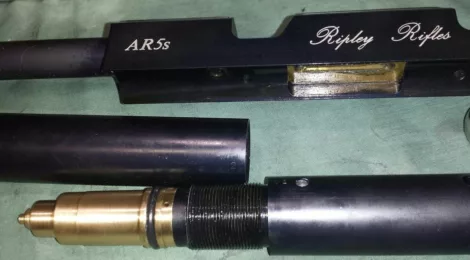
You were asking about barrels, guns, and power.
Here:
The guns I want to slug are: ● RTI Prophet I • .22cal • CZ 400mm barrel • Choked • 1:17.7"(?) twist rate • 30FPE
● RTI Prophet II • .25cal • RPB 510mm barrel • Lightly choked • 1:20" twist rate ▪ 60FPE
● Diana Skyhawk • .22cal • LW aftermarket 500mm barrel • Choked • 1:17.5" twist rate ▪ 30FPE

OK, I'm trying to write a step-by-step summary of your excellent suggestions. Please, correct me, or answer my questions as indicated below:


Get a wooden dowel, a bit longer than the barrel — a thin stick (smaller than the caliber of the barrel). They are usually sold for woodworking or in craft supply stores. A rigid barrel cleaning rod might work, too, but can damage the barrel. Brass is preferred as it is softer than the steel of the barrel. Best is a carbon fiber rod.

Remove the barrel from the gun, with all the precautions necessary for removal and reinstallation.

Remove any silencers or shrouds from the barrel.

Take a slug. It is preferable that the slug is slightly "too large" for the barrel. This could be accomplished by hitting it lightly and straight down with a hammer while it stands on a solid surface.

Using the dowel, push a slug from the breech to the muzzle.
Some lubricant might make this easier (clean up afterwards).
If the barrel is choked, do not push it all the way through, but stop before the choke, and push the slug back out the breech.
It is best to use a shorter dowel at first, as they easily break off.

Get a caliper that is able to accurately measure (not just display) lenghts of 0.0001" (0.00254mm) (±10% precision of 0.001").
Or get a micrometer.
I checked, and the seller declares that my calipers don't provide that accuracy

— as they only are accurate to 0.001" (meaning they could be off by ±50%, so that 0.0015" and 0.0005" would read the same 0.001"). ➠

Is this correct reasoning?

Count the grooves of the barrel.
● If they are an even number, measure the size of the slug with a caliper after pushing it through the barrel.
● If the grooves are an uneven number, the caliper would not give an accurate reading (as one of the measuring brackets would be measuring an indentation from a barrel land instead of the full diameter of the slug).
Therefore, use a thin flexible piece of metal. ➠

What kind — where would I get that from?
Measure the thickness of the metal.
Wrap it tightly around the slug once; this will give an even surface for measuring with the caliper. Measure the diameter (slug plus the metal wrap).
From the diameter measurement deduct the thickness of the metal wrap *twice*. This is called the groove diameter of the barrel — the diameter from groove to groove (the indentations in the barrel, not the lands [ridges]). ➠

Is that correct?

The slug diameter that
most likely will be better than others is the barrel inside diameter PLUS a certain amount that is not agreed upon:
I see people saying between 0.0005" and 0.001" (0.0254mm and 0.0127mm), others simply 0.001", and others yet 0.003".
➠ So this seems to be a point of disagreement...? Maybe?

Matthias

